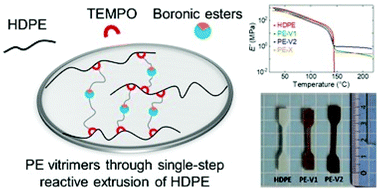Transformation of polyethylene into a vitrimer by nitroxide radical coupling of a bis-dioxaborolane†
Abstract
Vitrimers are a new class of polymeric materials that combine the re-processability of thermoplastics with the superior chemical and thermo-mechanical properties of thermosets. Transformation of existing thermoplastics, especially commodity plastics, into vitrimers during their processing is an exciting challenge that could greatly facilitate the industrial development of these materials. In this study, we combined nitroxide chemistry, for radical grafting, and boronic ester metathesis, as an associative exchange reaction, to prepare PE vitrimers via a single-step reactive extrusion of commercial HDPE. After studying the grafting efficiency of a model nitroxide carrying a dioxaborolane moiety, a bis-dioxaborolane bearing two nitroxide functions was used to synthesize vitrimers. The functionalization degree and its impact on the degree of crystallinity of vitrimers were quantified. The flow properties, thermal stability and thermo-mechanical properties of the resulting vitrimers were also studied. We found that associative exchange reactions allow full stress relaxation and provide processability to the vitrimers up to approximately 200 °C. Above this temperature, the thermolabile alkoxyamine bonds within the cross-links irreversibly dissociate, resulting in a material with a zero-shear viscosity comparable to that of the starting HDPE. The recyclability of these vitrimers was successfully exemplified with successive cycles of processing and mechanical testing, while their creep resistance at 80 °C was compared to that of their HDPE precursor.

- This article is part of the themed collection: Pioneering Investigators


 Please wait while we load your content...
Please wait while we load your content...